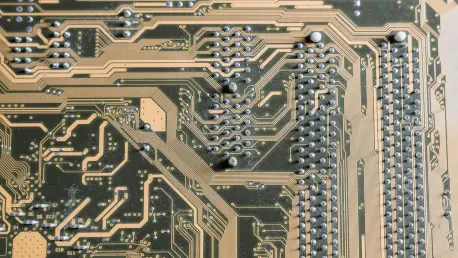Market Context: A Semiconductor Storm Hits 5G
The semiconductor industry, a vital engine of technological progress, is grappling with unprecedented challenges, and Intel’s staggering financial downturn is at the epicenter of this storm, creating significant ripples across the 5G landscape. With a reported net loss of $19.2 billion and sweeping strategic overhauls, Intel’s struggles are reverberating through the 5G radio access network (RAN) market, creating ripples for key players like Samsung and Nokia. This market analysis aims to dissect how these disruptions are reshaping competitive dynamics, driving up costs, and forcing vendors to rethink dependencies in a landscape critical to global connectivity. By examining current trends, financial data, and strategic shifts, this piece seeks to illuminate the broader implications for 5G deployment and innovation, providing stakeholders with actionable insights into navigating this turbulent period.
In-Depth Market Analysis: Trends, Data, and Projections
Financial Pressures Mount in the RAN Ecosystem
The 5G RAN sector is under immense financial strain, exacerbated by Intel’s crisis and soaring semiconductor production costs. Data reveals that chip production expenses have ballooned, with costs for a 2-nanometer chip reaching $725 million today, a sharp contrast to $48 million for a 28-nanometer chip over a decade ago, as highlighted by industry figures from Samsung. Concurrently, RAN vendors face a shrinking market, with collective annual sales dropping by $10 billion over recent years to a mere $35 billion, according to Omdia reports. For Samsung, holding a 4.8% market share, and Nokia, with 17.6%, the pressure to absorb these costs while maintaining innovation is acute, especially as Intel’s restructuring threatens supply chain stability.
This financial squeeze is not just a numbers game; it directly impacts strategic planning. Intel’s potential divestiture of its Network and Edge (NEX) group, a cornerstone for RAN technology, introduces uncertainty for vendors reliant on its components. Samsung, in particular, faces heightened risks due to its deep integration with Intel CPUs in virtual RAN deployments for major clients like Verizon. The market must now brace for potential cost spikes or delays if access to critical technology shifts under new ownership, pushing companies to reevaluate budgets and investment priorities.
Strategic Dependencies and the Hunt for Alternatives
Beyond financial woes, Intel’s dominant position in virtual RAN CPUs creates significant dependency risks for players like Samsung. With Intel holding a near-monopoly in this space, any disruption—such as a competitor acquiring NEX—could severely hamper Samsung’s ability to deliver on contracts. Nokia, while more diversified through partnerships with Broadcom and Marvell for purpose-built RAN components, is not immune to industry-wide shifts and still requires robust CPU alternatives for virtualized networks. The search for substitutes like AMD, Arm, and Nvidia is underway, but each option carries integration challenges and cost implications.
Market analysis indicates that AMD could serve as a near-term solution for Samsung due to its compatible x86 architecture, though concerns linger over the added expense and power draw of discrete accelerators. Arm presents a different hurdle with its distinct instruction set, potentially slowing adoption due to compatibility issues. Nvidia’s push for an AI-RAN model, leveraging GPUs for network functions, sparks interest but faces skepticism over economic viability. The trend toward diversification is clear, yet the path is fraught with technical and strategic barriers that could delay 5G rollouts if not addressed swiftly.
Technological Shifts and Regional Market Dynamics
Technological paradigms are shifting rapidly in the 5G RAN space, driven by both Intel’s instability and broader industry trends. The move from custom-built silicon to general-purpose chips like CPUs and GPUs is gaining momentum, fueled by economic realities and faster innovation cycles in general-purpose technology. Virtualization, which uses standard server hardware for network functions, is becoming a preferred approach, with Intel’s processors remaining a default choice despite corporate challenges. However, technical bottlenecks, such as Layer 1 processing for tasks like forward error correction, continue to demand specialized solutions, complicating transitions for vendors.
Regional disparities further shape market dynamics, adding layers of complexity. In Europe, power efficiency is a top priority, influencing hardware choices and adoption rates of new architectures. Conversely, high-density deployments in Asia call for scalable, robust solutions that can handle intense traffic loads. These variations highlight the need for tailored strategies, as a one-size-fits-all approach to chip integration risks falling short. Industry sentiment also reflects caution toward unproven models like Nvidia’s AI-RAN, with cost and power concerns dominating discussions, underscoring the importance of balancing innovation with practicality across diverse markets.
Future Outlook: Emerging Trends and Projections
Looking ahead, the 5G RAN market is poised for transformative changes, with general-purpose silicon projected to dominate within the next few years. Industry forecasts suggest that by 2027, virtualization could account for a significant portion of network deployments, driven by cost efficiencies and flexibility. Intel’s ongoing restructuring, including workforce reductions and unit divestitures, will likely accelerate this shift as vendors seek to mitigate risks tied to a single supplier. Regulatory factors, such as potential scrutiny over NEX ownership changes, could also influence technology access and market competition.
Innovative approaches, such as Nvidia’s vision of integrating AI and network tasks on GPUs, hint at a converged future, though adoption remains uncertain due to economic constraints. Samsung and Nokia are expected to intensify partnerships with alternative providers like AMD in the short term, while investing in research for longer-term solutions involving Arm or other architectures. Market projections indicate a growing emphasis on multi-vendor strategies to avoid lock-in, with operators likely to demand continuity plans from RAN providers to safeguard against disruptions. This evolving landscape signals a critical juncture for stakeholders to adapt or risk falling behind in the race for 5G dominance.
Final Reflections and Strategic Pathways
Reflecting on the analysis, Intel’s crisis proved to be a defining moment for the 5G RAN market, exposing vulnerabilities for Samsung while prompting Nokia to leverage its diversified approach. The financial burdens of escalating chip costs, coupled with the industry pivot toward general-purpose silicon, underscored a period of intense adaptation. Technical complexities and regional market needs further complicated the transition, revealing a sector at a crossroads between stability and innovation.
Moving forward, strategic pathways emerged as essential for navigating this shifted terrain. Stakeholders were encouraged to prioritize immediate diversification of chip suppliers, focusing on compatible options like AMD to ensure continuity. Long-term investments in R&D for alternative architectures, such as Arm, were deemed crucial to future-proof operations. Operators needed to collaborate closely with vendors to develop robust contingency plans, while industry professionals were urged to enhance skills in virtualized systems. These actionable steps offered a roadmap for resilience, ensuring that the challenges posed by Intel’s struggles became a catalyst for stronger, more adaptable 5G ecosystems.









